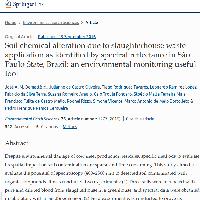Resumen
-
Despite environmental damage of cow meet production residues, specific methods to evaluate its spatial impact on soil contamination are sparse and time consuming. This study aimed to evaluate the potential of spectroscopy (400–2500 nm) to detected soil contaminated with organic compounds. It was conducted two experiments: (1) Three soils were incubated with pure and diluted blood from slaughterhouse in a greenhouse, and spectral data were obtained in laboratory with a FieldSpec sensor. (2) Field experiment was conducted to prove its approach. Soil spectral responses were evaluated by qualitative and quantitative methods, and chemical analyses were carried out. The addition of residues increased levels mostly of Na (92.9 %), Ca (80.9 %) and K (82.7 %). N and C increased 52.7 %. This high significant addition resulted on a decrease in soil reflectance intensity in all spectral ranges. These changed slightly at 650, 1450, 1550, 1900 and 2100 nm indicating alteration due to cation on the CEC of minerals. Principal components and soil line analyses corroborated the discrimination of samples quantification of Na, K, Ca and Mg, where R 2 vary from 0.68 until 0.85. In field areas with and without the waste also showed different spectra. Spectra were also able to analyze samples located downhill from the area with waste, indicating the presence of the waste close to streams, which came by leaching. The results indicate that it is possible to identify areas with organic residue by a quick method as compared with traditional soil analysis, helping man power inspection.
